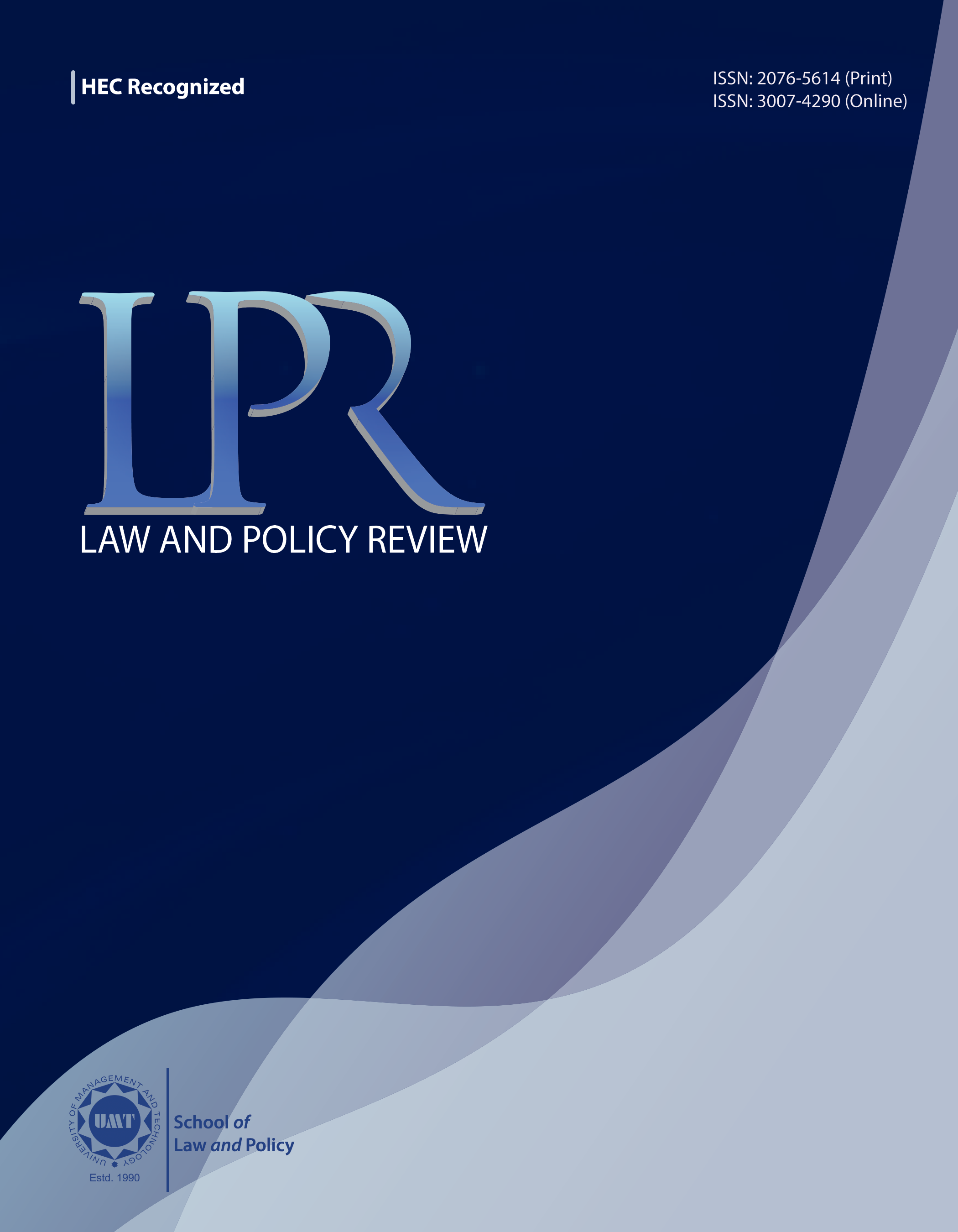Constitution, Environment, and Global Challenges: A Study of Chinese Constitution and Environmental Treatment in China
Abstract
 Abstract Views: 0
Abstract Views: 0
Studies have evidently shown that environmental disturbances cause existential threats for the entire global life. Diverse efforts have been made globally to preserve and sustain the environment and natural resources to ensure human existence. Various legal measures have been put in place at national, international, and regional levels which include constitutional provisions, environmental rules regulations, and policies. China, being a major global producer, is one of the largest contributors of global warming and also faces a number of environmental issues domestically. Therefore, the current study aimed to explore the environmental treatment by Chinese Constitution along with an analysis of environmental legal mechanism of China. Moreover, it also provided a brief picture of environment-human rights relationship and the current status of environmental constitutionalization across the world. The greatest task for China is to overcome the environmental challenges without compromising its economy. China has yet to decorate its constitution with an express environmental right, however, it places considerable significance on its protection. Since 1970s, China has been placing a progressive environmental enforcement mechanism to ensure environmental protection. Moreover, it has also enacted multiple legislative instruments at different governance levels through various enforcement bodies. A recent example is the inclusion of concept of ecological civilization in the constitution. Still, it remains a mighty task to ensure environmental sustainability, both nationally and globally, especially in the context of Belt and Road Initiative (BRI).
Downloads
References
Belt and Road Portal. (2017, May 8). Guidance on promoting green belt and road. https://eng.yidaiyilu.gov.cn/p/12479.html
Boyd, D. R. (2012). The constitutional right to a healthy environment. Environment: Science and Policy for Sustainable Development, 54(4), 3–15. https://doi.org/10.1080/00139157.2012.691392
Cheng, L. K. (2016). Three questions on China’s “belt and road initiative.” China Economic Review, 40, 309–313. https://doi.org/10.1016/J.CHIECO.2016.07.008
Daly, E., & May, J. R. (2012). Constitutional environmental rights and liabilities:The benefits of environmental process. International Journal of Peace Studies, 17(2), 71–80.
Feng, S. (2019). The predicament and realization path of China’s eco-civilization construction. IOP Conference Series: Earth and Environmental Science, 237(5), Article e52022. https://doi.org/10.1088/1755-1315/237/5/052022
Geng, Q., & Lo, K. (2023). Global ecological civilization: An analysis of macro-level policies of the Belt and Road Initiative. Research in Globalization, 7, Article e100141. https://doi.org/10.1016/j.resglo.2023.100141
Hansen, M. H., Li, H., & Svarverud, R. (2018). Ecological civilization: Interpreting the Chinese past, projecting the global future. Global Environmental Change, 53, 195–203. https://doi.org/10.1016/J.GLOENVCHA.2018.09.014
Harlan, T. (2021). Green development or greenwashing? A political ecology perspective on China’s green Belt and Road. Eurasian Geography and Economics, 62(2), 202–226. https://doi.org/10.1080/15387216.2020.1795700
Hart, M., & Cavanagh, J. (2012, April 20). Environmental standards give the United States an edge over China. Center for American Progress. https://www.americanprogress.org/article/environmental-standards-give-the-united-states-an-edge-over-china/
International Criminal Court. (1997). Separate opinion of vice-president weeramantry. ICC Legal Tools Database. https://www.legal-tools.org/doc/e45b69/pdf
Jiang, S., & Lu, Q. (2018). New measure of environmental protection in China. The Lancet Planetary Health, 2(12), Article e517. https://doi.org/10.1016/S2542-5196(18)30227-4
Kahn, J., & Yardley, J. (2007, August 26). As China roars, pollution reaches deadly extremes. The New York Times. https://www.nytimes.com/2007/08/26/world/asia/26china.html
Ksentini, F. Z. (1994, July 6). Human rights and the environment : Final report. United Nation Digital Library. https://digitallibrary.un.org/record/226681
Law, D. S., & Versteeg, M. (2012). The declining influence of the United States constitution. New York University Law Review, 87(3), 762–858.
Lim, L. (2007, May 17). Air pollution grows in tandem with China’s economy.NPR. https://www.npr.org/2007/05/17/10221268/air-pollution-grows-in-tandem-with-chinas-economy
Liu, M., Lo, K., Westman, L., & Huang, P. (2022). Beyond the North-South divide: The political economy and multi-level governance of international low-carbon technology transfer in China. Environmental Innovation and Societal Transitions, 44, 194–204. https://doi.org/10.1016/J.EIST.2022.07.001
Lo, K. (2015). How authoritarian is the environmental governance of China? Environmental Science & Policy, 54, 152–159. https://doi.org/10.1016/J.ENVSCI.2015.06.001
Ministry of Ecology and Environment. (n.d.-a). History. Retrieved June 20, 2024, from https://english.mee.gov.cn/About_MEE/History/
Ministry of Ecology and Environment. (n.d.-b). Mission. Retrieved June 20, 2024, from https://english.mee.gov.cn/About_MEE/Mission/
Ranjha, K. M. (2022). Environmental governance challenges in South Asia. InH. N. A. Yong, X. Yuan& L. Low (Eds.), China’s belt and road initiative: Going global and transformation in the global arena (pp. 151–177). World Scientific.
Sacks, D. (2021, March 24). Countries in China’s belt and road initiative: Who’s in and who’s out. Council on Foreign Relations. https://www.cfr.org/blog/countries-chinas-belt-and-road-initiative-whos-and-whos-out
Sam, A. G., & Zhang, X. (2020). Value relevance of the new environmental enforcement regime in China. Journal of Corporate Finance, 62, Article e101573. https://doi.org/10.1016/J.JCORPFIN.2020.101573
Silk, R. (2013, July 23). China weighs environmental costs. The Wall Street Journal. https://www.wsj.com/articles/SB10001424127887324879504578597462908226052
Tsuji, C. (2024, July 28). Belt and road initiative (BRI): Chinese-led infrastructure project. Britannica. https://www.britannica.com/topic/Belt-and-Road-Initiative
United Nations. (2021, June 8). Restoring ecosystems for a better homeland. http://geneva.china-mission.gov.cn/eng/dbtyw/kjhf/202106/t20210609_9129825.htm
United Nations Developemnet Program. (2022). What is the right to a healthy environment?https://www.undp.org/sites/g/files/zskgke326/files/2023-01/UNDP-UNEP-UNHCHR-What-is-the-Right-to-a-Healthy-Environment.pdf
Wei, C.,& Hu, T. (2019, February7). Annotated translation: 2018 amendment to the PRC constitution (Version 2.0). https://npcobserver.com/2018/03/china-constitution-amendment/
Wu, J., Feng, Z., & Ma, C. (2024). Promotion incentives and environmental regulation: evidence from China’s environmental one-vote veto evaluation regime. Environmental and Resource Economics, 87(1), 257–286. https://doi.org/10.1007/S10640-023-00824-Z/TABLES/9
Zhang, B., Cao, C., Hughes, R. M., & Davis, W. S. (2017). China’s new environmental protection regulatory regime: Effects and gaps. Journal of Environmental Management, 187, 464–469. https://doi.org/10.1016/J.JENVMAN.2016.11.009
Zhao, Y. (2021). Chinese environmental law. Cambridge University Press.
Copyright (c) 2024 Khalid Mahmood Ranjha

This work is licensed under a Creative Commons Attribution 4.0 International License.
LPR follow an open-access publishing policy and full text of all published articles is available free, immediately upon publication of an issue. The journal’s contents are published and distributed under the terms of the Creative Commons Attribution 4.0 International (CC-BY 4.0) license. Thus, the work submitted to the journal implies that it is original, unpublished work of the authors (neither published previously nor accepted/under consideration for publication elsewhere). On acceptance of a manuscript for publication, a corresponding author on the behalf of all co-authors of the manuscript will sign and submit a completed the Copyright and Author Consent Form.





